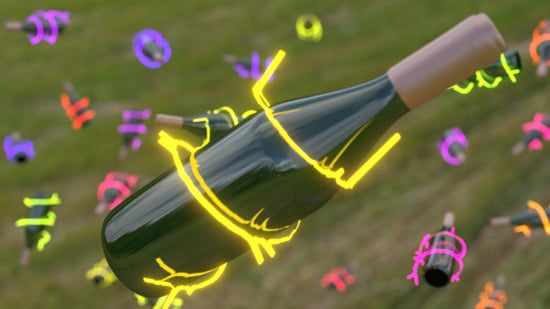Cool-Climate Red Wines—Chemical Composition and Comparison of Two Protocols for 1H–NMR Analysis
Abstract
:1. Introduction
2. Results
2.2. Multivariate Analysis
2.3. Quality Control of 1H-NMR Data
3. Discussion
4. Materials and Methods
4.1. Experimental Design
4.2. Chemicals
4.3. 1H-NMR Spectroscopy
4.3.1. Sample Preparation
4.3.2. 1H-NMR Measurements
4.4. Multivariate Analysis
4.4.1. Preprocessing of the 1H-NMR Data
4.4.2. Principal Component Analysis (PCA)
4.4.3. Quality Control of the 1H-NMR Data
5. Conclusions
Acknowledgments
Author Contributions
Conflicts of Interest
References
- Polášková, P.; Herszage, J.; Ebeler, S.E. Wine flavor: Chemistry in a glass. Chem. Soc. Rev. 2008, 37, 2478. [Google Scholar] [CrossRef] [PubMed]
- Guilford, J.M.; Pezzuto, J.M. Wine and health: A review. Am. J. Enol. Vitic. 2011, 62, 471–486. [Google Scholar] [CrossRef]
- Scalbert, A.; Johnson, I.T.; Saltmarsh, M. Polyphenols Antioxidants and Beyond. Am. J. Clin. Nutr. 2005, 81, 215S–217S. [Google Scholar] [PubMed]
- Pandey, K.B.; Rizvi, S.I. Plant Polyphenols as Dietary Antioxidants in Human Health and Disease. Oxid. Med. Cell. Longev. 2009, 2, 270–278. [Google Scholar] [CrossRef] [PubMed]
- Mohamed Saleem, T.S.; Darbar Basha, S. Red wine: A drink to your heart. J. Cardiovasc. Dis. Res. 2010, 1, 171–176. [Google Scholar] [CrossRef] [PubMed]
- Cooper, K.A.; Chopra, M.; Thurnham, D.I. Wine polyphenols and promotion of cardiac health. Nutr. Res. Rev. 2004, 17, 111–130. [Google Scholar] [CrossRef] [PubMed]
- Corder, R.; Mullen, W.; Khan, N.Q.; Marks, S.C.; Wood, E.G.; Carrier, M.J.; Crozier, A. Oenology: Red wine procyanidins and vascular health. Nature 2006, 444, 566. [Google Scholar] [CrossRef] [PubMed]
- Gorelik, S.; Ligumsky, M.; Kohen, R.; Kanner, J. A novel function of red wine polyphenols in humans: Prevention of absorption of cytotoxic lipid peroxidation products. FASEB J. 2007, 22, 41–46. [Google Scholar] [CrossRef] [PubMed]
- Bertelli, A.A.A.; Das, D.K. Grapes, wines, resveratrol, and heart health. J. Cardiovasc. Pharmacol. 2009, 54, 468–476. [Google Scholar] [CrossRef] [PubMed]
- Das, D.K.; Mukherjee, S.; Ray, D. Resveratrol and red wine, healthy heart and longevity. Heart Fail. Rev. 2010, 15, 467–477. [Google Scholar] [CrossRef] [PubMed]
- Khakimov, B.; Engelsen, S.B. Resveratrol in the foodomics era: 1:25,000. Ann. N. Y. Acad. Sci. 2017, 1403, 48–58. [Google Scholar] [CrossRef] [PubMed]
- Son, H.S.; Hwang, G.S.; Kim, K.M.; Ahn, H.J.; Park, W.M.; Van Den Berg, F.; Hong, Y.S.; Lee, C.H. Metabolomic studies on geographical grapes and their wines using 1H NMR analysis coupled with multivariate statistics. J. Agric. Food Chem. 2009, 57, 1481–1490. [Google Scholar] [CrossRef] [PubMed]
- Liu, J.; Arneborg, N.; Toldam-Andersen, T.B.; Zhang, S.; Petersen, M.A.; Bredie, W.L.P. Impact of sequential co-culture fermentations on flavour characters of Solaris wines. Eur. Food Res. Technol. 2017, 243, 437–445. [Google Scholar] [CrossRef]
- Liu, J.; Arneborg, N.; Toldam-Andersen, T.B.; Petersen, M.A.; Bredie, W.L.P. Effect of sequential fermentations and grape cultivars on volatile compounds and sensory profiles of Danish wines. J. Sci. Food Agric. 2017, 97, 3594–3602. [Google Scholar] [CrossRef] [PubMed]
- Rochfort, S.; Ezernieks, V.; Bastian, S.E.P.; Downey, M.O. Sensory attributes of wine influenced by variety and berry shading discriminated by NMR metabolomics. Food Chem. 2010, 121, 1296–1304. [Google Scholar] [CrossRef]
- Lee, J.E.; Hwang, G.S.; Van Den Berg, F.; Lee, C.H.; Hong, Y.S. Evidence of vintage effects on grape wines using 1H NMR-based metabolomic study. Anal. Chim. Acta 2009, 648, 71–76. [Google Scholar] [CrossRef] [PubMed]
- Ioriatti, C.; Walton, V.; Dalton, D.; Anfora, G.; Grassi, A.; Maistri, S.; Mazzoni, V. Drosophila suzukii (Diptera: Drosophilidae) and Its Potential Impact to Wine Grapes During Harvest in Two Cool Climate Wine Grape Production Regions. J. Econ. Entomol. 2015, 108, 1148–1155. [Google Scholar] [CrossRef] [PubMed]
- Jackson, R.S. Wine Science—Principles and Applications; Academic Press: Cambridge, MA, USA, 2008; ISBN 9780123736468. [Google Scholar]
- Olsen, J.L.; Olsen, A.; Breuning-Madsen, H.; Balstron, T. A method to identify potential cold-climate vine growing sites—A case study from Røsnæs in Denmark. Dan. J. Geogr. 2011, 111, 73–84. [Google Scholar] [CrossRef]
- Lederer, M.A.; Nielsen, D.S.; Toldam-Andersen, T.B.; Herrmann, J.V.; Arneborg, N. Yeast species associated with different wine grape varieties in Denmark. Acta Agric. Scand. Sect. B Soil Plant Sci. 2013, 63, 89–96. [Google Scholar] [CrossRef]
- Ebeler, S.E. Analytical Chemistry: Unlocking the Secrets of Wine Flavor. Food Rev. Int. 2001, 17, 45–64. [Google Scholar] [CrossRef]
- De Villiers, A.; Alberts, P.; Tredoux, A.G.J.; Nieuwoudt, H.H. Analytical techniques for wine analysis: An African perspective; a review. Anal. Chim. Acta 2012, 730, 2–23. [Google Scholar] [CrossRef] [PubMed]
- Larive, C.K.; Barding, G.A.; Dinges, M.M. NMR spectroscopy for metabolomics and metabolic profiling. Anal. Chem. 2015, 87, 133–146. [Google Scholar] [CrossRef] [PubMed]
- Fotakis, C.; Kokkotou, K.; Zoumpoulakis, P.; Zervou, M. NMR metabolite fingerprinting in grape derived products: An overview. Food Res. Int. 2013, 54, 1184–1194. [Google Scholar] [CrossRef]
- López-Rituerto, E.; Savorani, F.; Avenoza, A.; Busto, J.H.; Peregrina, J.M.; Engelsen, S.B. Investigations of la Rioja terroir for wine production using 1H NMR metabolomics. J. Agric. Food Chem. 2012, 60, 3452–3461. [Google Scholar] [CrossRef] [PubMed]
- Alañón, M.E.; Pérez-Coello, M.S.; Marina, M.L. Wine science in the metabolomics era. TrAC Trends Anal. Chem. 2015, 74, 1–20. [Google Scholar] [CrossRef]
- Hong, Y.S. NMR-based metabolomics in wine science. Magn. Reson. Chem. 2011, 49. [Google Scholar] [CrossRef] [PubMed]
- Lopez-Rituerto, E.; Cabredo, S.; Lopez, M.; Avenoza, A.; Busto, J.H.; Peregrina, J.M. A Thorough Study on the Use of Quantitative H-1 NMR in Rioja Red Wine Fermentation Processes. J. Agric. Food Chem. 2009, 57, 2112–2118. [Google Scholar] [CrossRef] [PubMed]
- Son, H.-S.; Hwang, G.-S.; Ahn, H.-J.; Park, W.-M.; Lee, C.-H.; Hong, Y.-S. Characterization of wines from grape varieties through multivariate statistical analysis of 1H NMR spectroscopic data. Food Res. Int. 2009, 42, 1483–1491. [Google Scholar] [CrossRef]
- Monakhova, Y.B.; Schäfer, H.; Humpfer, E.; Spraul, M.; Kuballa, T.; Lachenmeier, D.W. Application of automated eightfold suppression of water and ethanol signals in 1H NMR to provide sensitivity for analyzing alcoholic beverages. Magn. Reson. Chem. 2011, 49, 734–739. [Google Scholar] [CrossRef] [PubMed]
- Anastasiadi, M.; Zira, A.; Magiatis, P.; Haroutounian, S.A.; Skaltsounis, A.L.; Mikros, E. 1H NMR-based metabonomics for the classification of Greek wines according to variety, region, and vintage. comparison with HPLC data. J. Agric. Food Chem. 2009, 57, 11067–11074. [Google Scholar] [CrossRef] [PubMed]
- Ali, K.; Maltese, F.; Toepfer, R.; Choi, Y.H.; Verpoorte, R. Metabolic characterization of Palatinate German white wines according to sensory attributes, varieties, and vintages using NMR spectroscopy and multivariate data analyses. J. Biomol. NMR 2011, 49, 255–266. [Google Scholar] [CrossRef] [PubMed]
- Duarte, I.; Barros, A.; Belton, P.S.; Righelato, R.; Spraul, M.; Humpfer, E.; Gil, A.M. High-resolution nuclear magnetic resonance spectroscopy and multivariate analysis for the characterization of beer. J. Agric. Food Chem. 2002, 50, 2475–2481. [Google Scholar] [CrossRef] [PubMed]
- Lin, C.Y.; Wu, H.; Tjeerdema, R.S.; Viant, M.R. Evaluation of metabolite extraction strategies from tissue samples using NMR metabolomics. Metabolomics 2007, 3, 55–67. [Google Scholar] [CrossRef]
- Ribéreau-Gayon, P.; Dubourdieu, D.; Glories, Y.; Maujean, A. Handbook of Enology: The Chemistry of Wine Stabilization and Treatments, 2nd ed.; Oxford University Press: Oxford, UK, 2006; Volume 2, ISBN 0470010371. [Google Scholar]
- Romano, P.; Brandolini, V.; Ansaloni, C.; Menziani, E. The production of 2,3-butanediol as a differentiating character in wine yeasts. World J. Microbiol. Biotechnol. 1998, 14, 649–653. [Google Scholar] [CrossRef]
- Son, H.-S.; Myong Kim, K.; Van der Berg, F.; Hwang, G.-S.; Park, W.-M.; Lee, C.-H.; Hong, Y.-S. 1H Nuclear Magnetic Resonance-Based Metabolomic Characterization of Wines by Grape Varieties and Korea Cabernet Sauvignon 2005. J. Agric. Food Chem. 2008, 56, 8007–8016. [Google Scholar] [CrossRef] [PubMed]
- Swiegers, J.H.; Bartowsky, E.J.; Hensche, P.A.; Pretorius, I.S. Yeast and bacterial modulation of wine aroma and flavour. Aust. J. Grape Wine Res. 2005, 11, 139–173. [Google Scholar] [CrossRef]
- Yanniotis, S.; Kotseridis, G.; Orfanidou, A.; Petraki, A. Effect of ethanol, dry extract and glycerol on the viscosity of wine. J. Food Eng. 2007, 81, 399–403. [Google Scholar] [CrossRef]
- Savorani, F.; Tomasi, G.; Engelsen, S.B. Icoshift: A versatile tool for the rapid alignment of 1D NMR spectra. J. Magn. Reson. 2010, 202, 190–202. [Google Scholar] [CrossRef] [PubMed]
- Monsonis Centelles, S.; Hoefsloot, H.C.J.; Khakimov, B.; Ebrahimi, P.; Lind, M.V.; Kristensen, M.; De Roo, N.; Jacobs, D.M.; Van Duynhoven, J.; Cannet, C.; et al. Toward Reliable Lipoprotein Particle Predictions from NMR Spectra of Human Blood: An Interlaboratory Ring Test. Anal. Chem. 2017, 89, 8004–8012. [Google Scholar] [CrossRef] [PubMed]
- Wold, S.; Esbensen, K.; Geladi, P. Principal component analysis. Chemom. Intell. Lab. Syst. 1987, 2, 37–52. [Google Scholar] [CrossRef]
- Amaral, F.M.; Caro, M.S.B. Investigation of different pre-concentration methods for NMR analyses of Brazilian white wine. Food Chem. 2005, 93, 507–510. [Google Scholar] [CrossRef]
Sample Availability: Samples of the compounds are not available from the authors. |

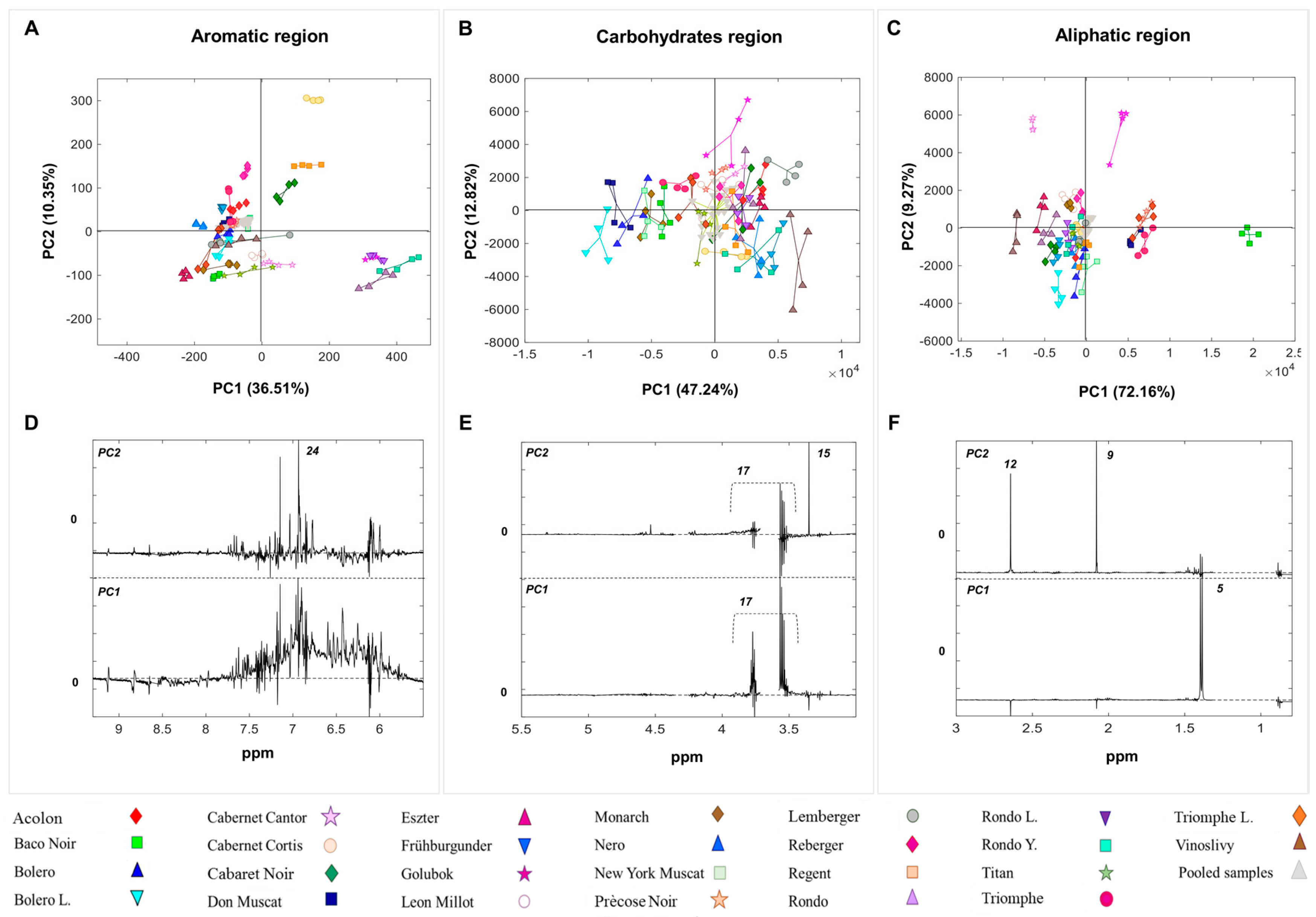
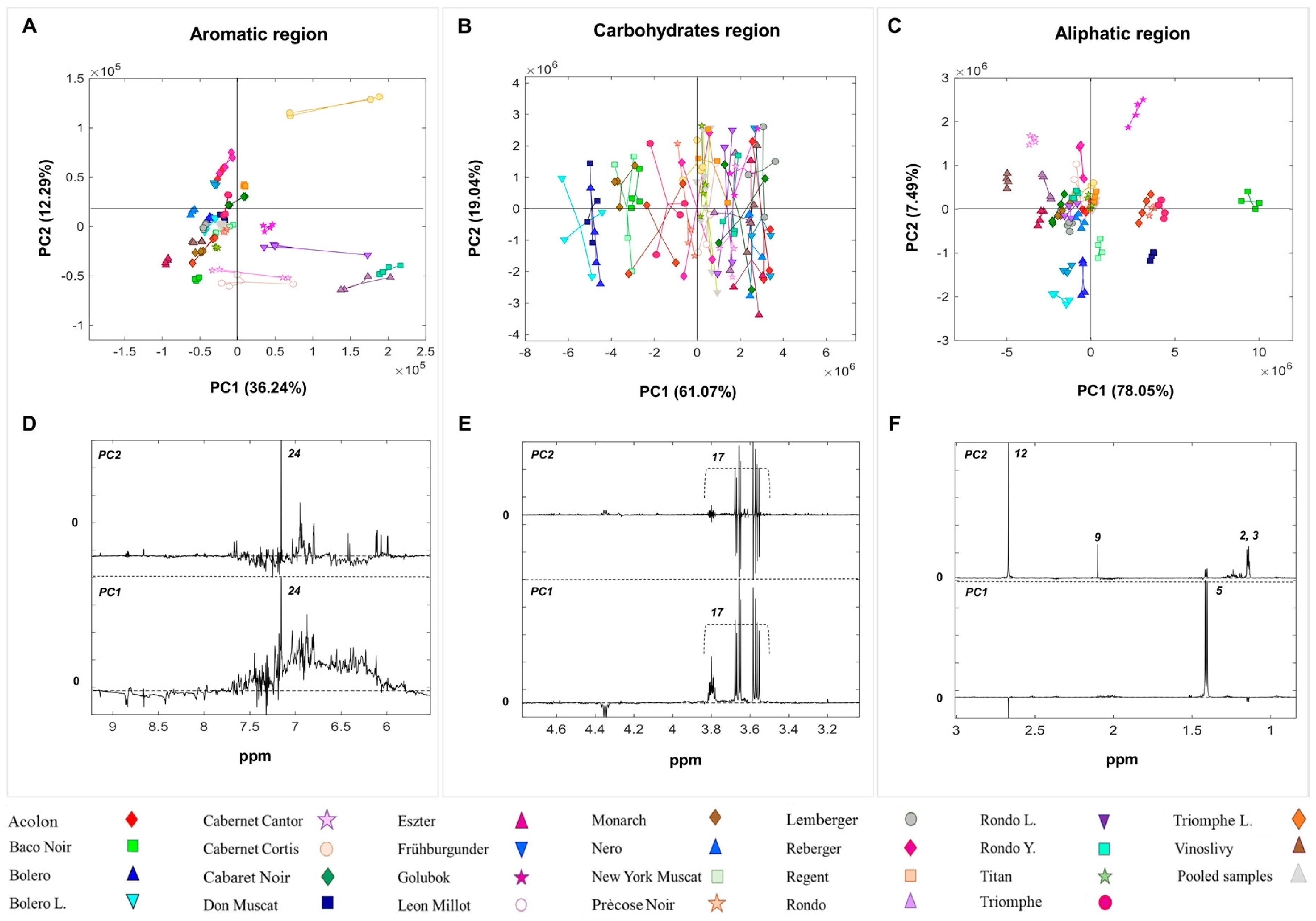
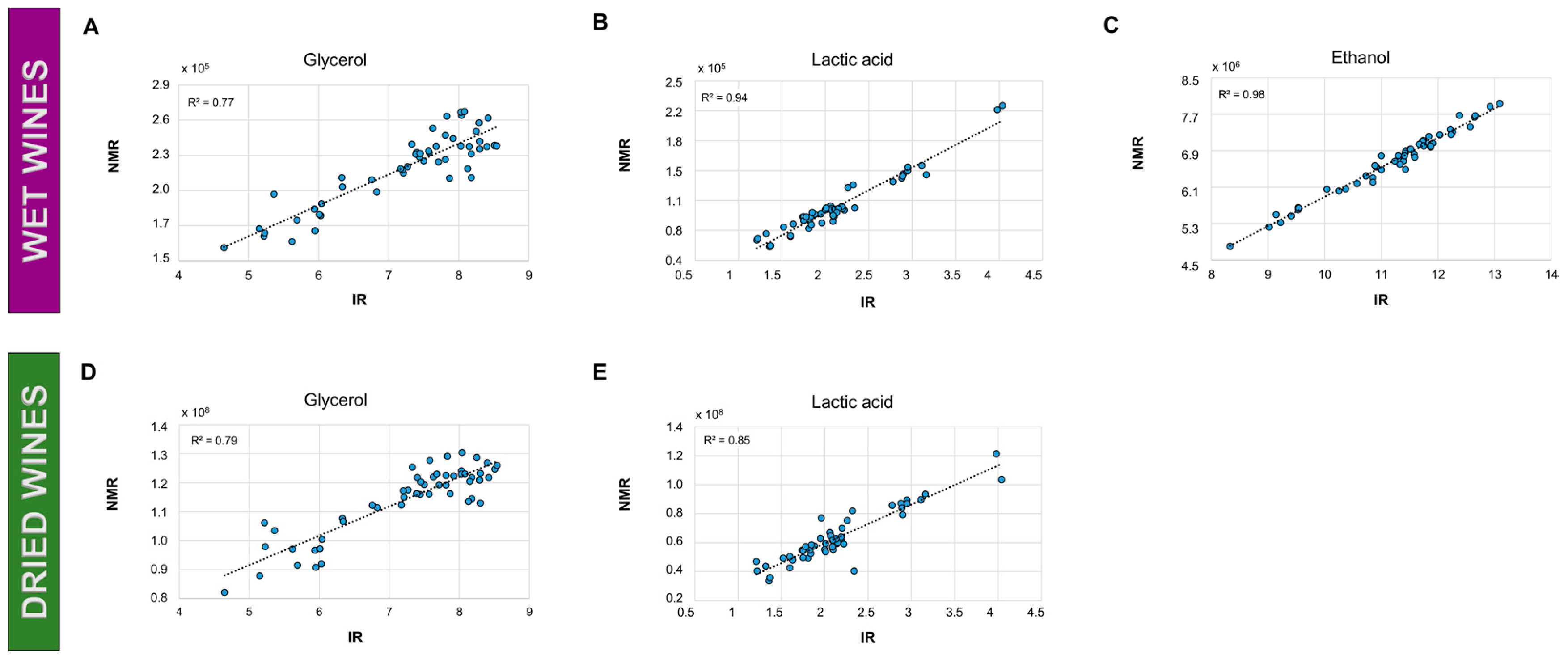

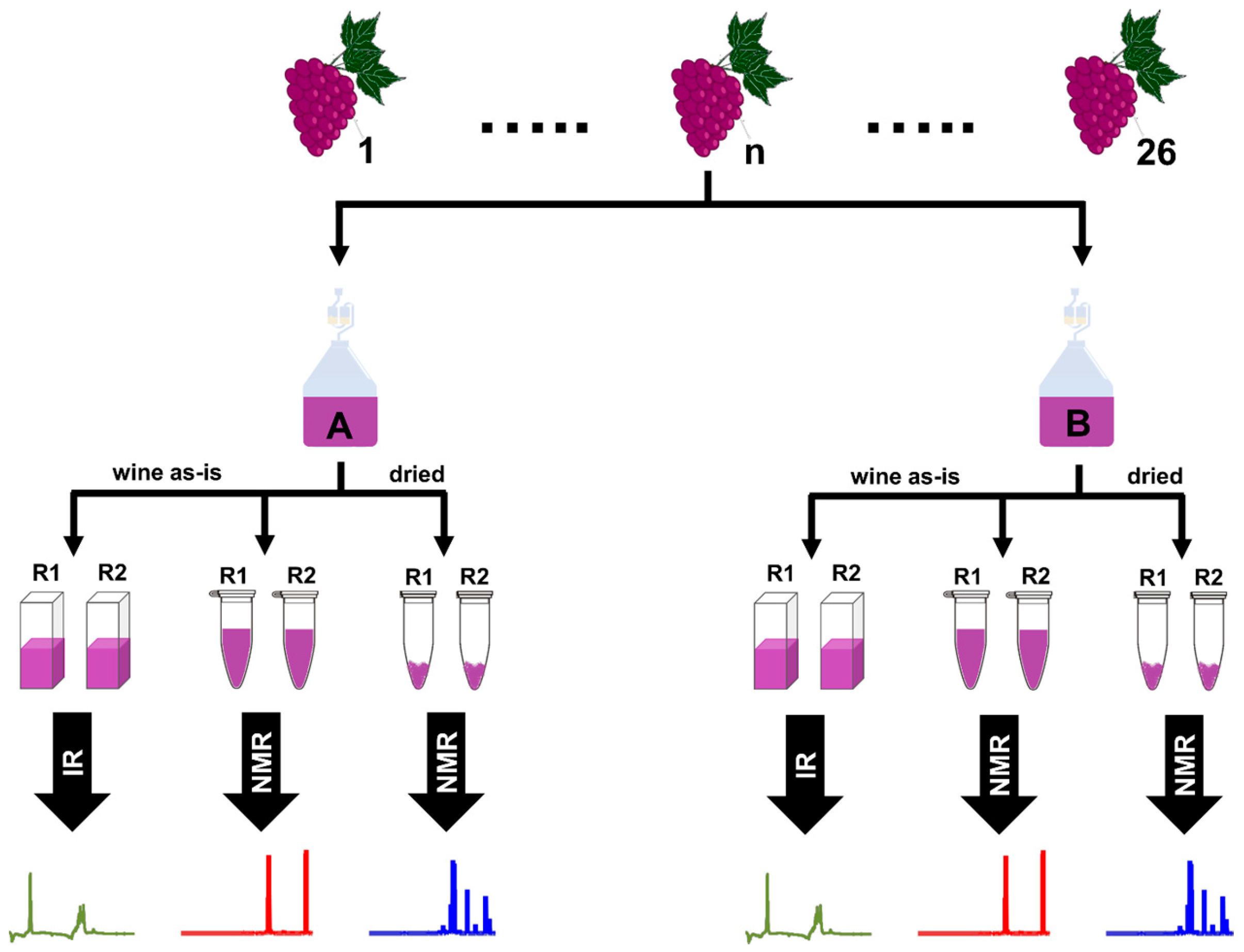
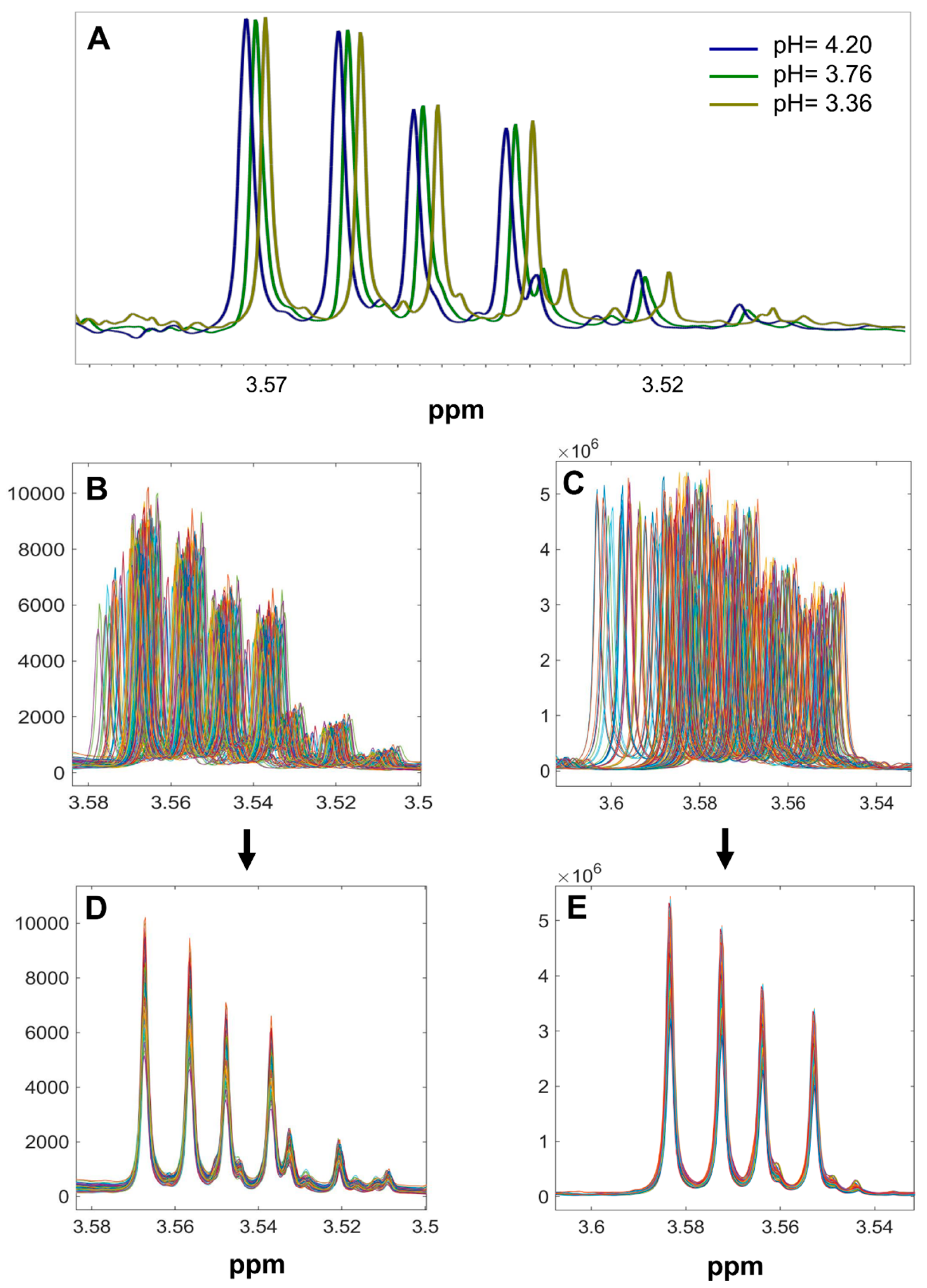
| Peak Numbers | Metabolite | Wet Wine | Dried Wine |
|---|---|---|---|
| 1 | Valine | 1.04 (d) | 1.01 (d), 1.05 (d) |
| 2 | 2,3-butanediol | 1.14 (d) | 1.15 (d) |
| 3 | Isopropanol | 1.13 (d) | 1.14 (d) |
| 4 | Ethanol | 1.17 (t), 1.65 (m) | / |
| 5 | Lactic Acid | 1.39 (d), 4.29 (m) | 1.41 (d), 4.34 (m) |
| 6 | Alanine | 1.48 (d) | 1.52 (d) |
| 7 | Arginine | 1.65 (m), 1.73 (m) | 1.66 (m), 1.74 (m) |
| 8 | Proline | 2.00 (m) | 2.02 (m) |
| 9 | Acetic Acid | 2.08 (s) | 2.12 (s) |
| 10 | Methionine | 2.08 (m) | 2.12 (m) |
| 11 | γ-aminobutyric acid | 2.48 (t) | 2.55 (t) |
| 12 | Succinic Acid | 2.64 (s) | 2.70 (s) |
| 13 | Choline | 3.19 (s) | 3.21 (s) |
| 14 | Myoinositol | 3.29 (t) | 3.32 (t) |
| 15 | Methanol | 3.35 (s) | / |
| 16 | Fructose | 3.50 (m) | 3.50 (m) |
| 17 | Glycerol | 3.55 (m), 3.78 (m) | 3.57 (m), 3.68 (m), 3.81 (m) |
| 18 | Tartaric Acid | 4.52 (s) | 4.58 (s) |
| 19 | β-glucose | 4.60 (d) | 4.61 (d) |
| 20 | α-glucose | 5.25 (d) | 5.26 (d) |
| 21 | Arabinose | 5.30 (d) | 5.30 (d) |
| 22 | cis-caftaric acid | 5.34 (s) | 5.34 (s) |
| 23 | Tyrosine | 6.88 (d), 7.18 (d) | 6.92 (d), 7.20 (d) |
| 24 | Gallic Acid | 7.14 (s) | 7.16 (s) |
| 25 | 2-pheniylethanol | 7.35 (m) | 7.37 (m) |
| 26 | Phenylalanine | 7.40 (m) | 7.41 (m) |
| 27 | Trigonelline | 8.06 (m), 8.84 (m), 9.13 (s) | 8.07 (m), 8.83 (m), 9.14 (s) |
| Grape Variety | Description | Wine Samples | pH | Glycerol (g/L) | Lactic Acid (g/L) | Ethanol (% vol.) |
|---|---|---|---|---|---|---|
| Acolon | ‘Acolon’ is a German wine grape variety created in 1971 by crossing ‘Lemberger’ (‘Blau Fränkisch’) and ‘Dornfelder’. Medium to large clusters and berries. It ripens early and produces a very colour-intensive wine with mild tannins. | A | 3.56 | 7.58 | 2.14 | 11.58 |
| B | 3.55 | 7.33 | 2.20 | 11.43 | ||
| Baco Noir | ‘Baco Noir’ is a hybrid grape variety produced in France in 1902 by crossing a French variety of Vitis vinifera named ‘Folle blanche’ and the native American Vitis riparia. Medium clusters with small berries. Wines made from ‘Baco Noir’ are known to be rustic, wild, and great for staining teeth because of their heavy pigment. | A | 3.35 | 5.22 | 4.04 | 9.53 |
| B | 3.39 | 5.36 | 3.98 | 9.53 | ||
| Bolero | ‘Bolero’ is an interspecific wine grape variety created in Germany in 1982. It is a cross between (‘Rotberger’ × ‘Reichensteiner’) and ’Chancellor’ grapes. It has Vitis rupestris in its pedigree. Large clusters and berries. It ripens quite early and produces a ruby red wine, harmonious on the palate with medium tannins. | A | 3.64 | 5.15 | 1.88 | 9.14 |
| B | 3.70 | 5.69 | 2.01 | 10.04 | ||
| A (L.) | 3.56 | 5.23 | 1.82 | 9.02 | ||
| B (L.) | 3.42 | 4.65 | 1.63 | 8.33 | ||
| Cabernet Cantor | ‘Cabernet Cantor’ is an interspecific red grape created in 1989 by crossing the grape varieties ‘Chancellor’, ‘Merzling’, ‘Zarya Severa’, and ‘Muscat Ottonel’. It gives a wine with dark berry and black pepper flavour, which is soft but rich in extract and phenolic compounds. | A | 3.89 | 7.40 | 1.21 | 11.00 |
| B | 3.88 | 7.50 | 1.22 | 10.91 | ||
| Cabernet Cortis | ‘Cabernet Cortis’ is a dark-skinned interspecific grape variety. It was bred in Germany in 1982 by crossing ‘Cabernet Sauvignon’ and ‘Solaris’. Medium-sized clusters and small to medium berries. It ripens relatively early and produces colourful and tannic wines with vegetal characters, which are very herby on the palate, rich in extract, and contains phenolic compounds. | A | 3.78 | 7.27 | 2.34 | 11.81 |
| B | 3.81 | 7.57 | 2.22 | 12.38 | ||
| Cabaret Noir | ‘Cabaret Noir’ is an interspecific grape variety created in Switzerland by the breeder V. Blattner in 1991 by crossing ‘Cabernet Sauvignon’ with an interspecific resistant cultivar. Clusters and berries are small. Produces a wine with cabernet character. | A | 4.00 | 7.71 | 1.81 | 12.26 |
| B | 4.07 | 8.03 | 1.84 | 12.65 | ||
| Don Muscat | ‘Don Muscat’ is a Russian cultivar. The genetic origin is unknown to us, but we believe it to be interspecific. It produces a light red wine, very rich in flowery, and fruity muscat flavours. | A | 3.93 | 5.62 | 2.78 | 9.22 |
| B | 3.99 | 5.95 | 2.88 | 9.41 | ||
| Eszter | ‘Eszter’ is an interspecific cultivar created in Hungary in 1969 by crossing ‘Eger 2’ and ‘Magaracsi’. It has Vitis berlandieri in its pedigree. It produces a light fruity aromatic wine. | A | 3.79 | 7.81 | 1.60 | 11.24 |
| B | 3.80 | 7.92 | 1.60 | 11.34 | ||
| Frühburgunder | ‘Frühburgunder’, known also as ‘Pinot Noir Précoce’, is the early ripening version of ‘Pinot Noir’. Clusters are small and tight with small berries. It is an old cultivar mutation likely to originate in France. It gives a light coloured soft and velvet Pinot style wine characterised by a fruity spicy aroma. | A | 4.04 | 8.29 | 1.96 | 12.66 |
| B | 4.12 | 8.25 | 2.09 | 12.57 | ||
| Golubok | ‘Golubok’ is a cultivar originating from Ukraine. The genetic background is unknown to us. Clusters and berries are medium sized. In this grape, the colour pigment is not only located in the skin, but a significant amount of pigment is also present in the pulp. This results in a deep, rich, dark, almost black colour and a unique flavour. | A | 4.07 | 8.40 | 2.32 | 10.57 |
| B | 4.04 | 8.51 | 2.26 | 10.73 | ||
| Lemberger | ‘Lemberger’ (or ‘Blau Fränkisch’) is an old cultivar assumed to origin in Austria or Franconia in Germany. ‘Heunisch’ is proven to be one of the parents. The tight clusters and berries are medium sized. It produces a well coloured fruity wine with dark berry flavours with a bit spicy character. The wines are well balanced with a good soft tannin structure. | A | 3.47 | 7.83 | 2.00 | 11.52 |
| B | 3.45 | 8.04 | 2.01 | 11.74 | ||
| Leon Millot | ‘Léon Millot’ is an old French hybrid created in 1911 in Alsace by crossing the hybrid grape ‘Millardet et Grasset’ (Vitis riparia × Vitis rupestris) with ‘Goldriesling’, which is a Vitis vinifera variety. The relatively early ripening makes it particularly suited for cultivation in cool climates. Clusters and berries are small. Common aromatic and flavour profiles for ‘Leon Millot’ include earthy, barnyard, woody notes, purple fruits, and chocolate. | A | 4.15 | 7.87 | 1.95 | 11.59 |
| B | 4.20 | 7.81 | 2.06 | 11.51 | ||
| Monarch | ‘Monarch’ is an interspecific grape variety breed in Germany in 1988. It is a crossing of ‘Solaris’ and ‘Dornfelder’. From Solaris it has several Vitis species in its pedigree. It produces a light fruity wine with red and dark berry flavours. | A | 3.42 | 6.04 | 1.74 | 9.53 |
| B | 3.45 | 6.03 | 1.75 | 9.54 | ||
| Nero | ‘Nero’ is an interspecific cultivar originating in Hungary. It was created in 1965 by crossing (‘Medoc Noir’ x ‘Perle von Csaba’) and (‘S.C 12375’ × ‘Gárdonyi’). Clusters and berries are medium to large and may be used as table grape. It produces a light aromatic wine with red berry flavours with a little muscat character. | A | 3.78 | 7.63 | 2.10 | 11.91 |
| B | 3.76 | 7.68 | 2.09 | 11.87 | ||
| New York Muscat | ‘New York Muscat’ is a cultivar made in US at Cornell University by crossing ‘Muscat Hamburg’ and ‘Ontario’. Clusters and berries are medium in size and may be enjoyed as table grape. It produces a deep red very aromatic wine with floral muscat flavours. | A | 3.86 | 5.94 | 2.07 | 10.37 |
| B | 3.90 | 6.01 | 2.07 | 10.25 | ||
| Précose Noir | ‘Précose Noir’ is an old French hybrid from the same breeding as ‘Triomphe d’Alsace. Clusters and berries are small to medium. Produces a medium dark red light bodied wine with dark berries and spicy aromas. | A | 3.90 | 7.21 | 2.90 | 11.42 |
| B | 3.88 | 7.20 | 2.89 | 11.39 | ||
| Reberger | ‘Reberger’ is an interspecific grape variety that was breed in Germany in 1986 by crossing the ‘Regent’ and ’Lemberger’ (‘Blau Fränkisch’). The loose clusters and berries are medium sized. It produces a light fruity wine with a tannic/phenolic character. | A | 3.83 | 7.44 | 2.20 | 12.03 |
| B | 3.70 | 7.17 | 2.11 | 11.73 | ||
| Regent | ‘Regent’ is an interspecific grape variety created in Germany in 1967 by crossing ‘Diana’ (‘Silvaner’ × ‘Müller-Thurgau’) with the hybrid ‘Chambourcin’. Clusters are relatively loose medium in size with small to medium berries. It gives colourful and tannic wines and shows aromas of cherries or black currants with peppery notes. | A | 3.89 | 7.39 | 2.19 | 12.22 |
| B | 3.88 | 7.45 | 2.15 | 12.23 | ||
| Rondo | ‘Rondo’ is an interspecific variety created in 1964 in then-Czechoslovakia by crossing ‘Zarya Severa’ × ‘St. Laurent’. It is characterised by a very early ripening which make it particularly suitable for cultivation in cool climates. Clusters and berries are medium sized. ‘Rondo’ produces a very dark red wine with dark berry and woody aromas. | A | 3.81 | 8.18 | 1.52 | 11.67 |
| B | 3.73 | 8.15 | 1.32 | 11.75 | ||
| A (L.) | 3.75 | 8.30 | 1.75 | 11.30 | ||
| B (L.) | 3.83 | 8.30 | 1.83 | 11.41 | ||
| A (Y.) | 3.73 | 8.03 | 1.78 | 11.87 | ||
| B (Y.) | 3.77 | 8.08 | 1.85 | 11.84 | ||
| Titan | ‘Titan’ is a cultivar developed at the research station in Eger in Hungary. The genetic origins is unknown to us, but believe it to be interspecific. The berries are characterised by coloured flesh resulting in a very dark almost black wine. Clusters and berries are medium in size. The wine has good dark berry flavours and rich good phenolic structure. | A | 3.92 | 8.18 | 2.13 | 10.85 |
| B | 3.93 | 8.13 | 2.09 | 10.85 | ||
| Triomphe d’Alsace | ‘Triomphe d’Alsace’ is an interspecific grape variety that was produced in France in 1911 by crossing the American grape species Vitis riparia with Vitis rupestris. The resultant hybrid was then crossed with ‘Goldriesling’ (Vitis vinifera). Clusters and berries are small. It produces a medium dark red light bodied wine with dark berries and spicy aromas. Quite similar to ‘Prècose Noir’. | A | 3.70 | 6.33 | 3.16 | 10.89 |
| B | 3.76 | 6.83 | 3.11 | 11.43 | ||
| A (L.) | 3.81 | 6.76 | 2.95 | 11.33 | ||
| B (L.) | 3.63 | 6.34 | 2.95 | 11.00 | ||
| Vinoslivy | ’Vinoslivy’ is an interspecific cultivar breed in Ukraine in 1958 by crossing ‘Getsh’ with (‘Muscat Hamburg’ × Vitis amurensis). It is very early ripening and accumulates relatively high sugar levels. The clusters and berries are small to medium. It produces a light red wine with an aroma rich in pyrazines. | A | 3.64 | 8.54 | 1.36 | 13.09 |
| B | 3.61 | 8.42 | 1.37 | 12.92 | ||
| Average | 3.78 | 7.23 | 2.14 | 11.16 | ||
| Max | 4.20 | 8.54 | 4.04 | 13.09 | ||
| Min | 3.35 | 4.65 | 1.21 | 8.33 |
© 2018 by the authors. Licensee MDPI, Basel, Switzerland. This article is an open access article distributed under the terms and conditions of the Creative Commons Attribution (CC BY) license (http://creativecommons.org/licenses/by/4.0/).
Share and Cite
Aru, V.; Sørensen, K.M.; Khakimov, B.; Toldam-Andersen, T.B.; Balling Engelsen, S. Cool-Climate Red Wines—Chemical Composition and Comparison of Two Protocols for 1H–NMR Analysis. Molecules 2018, 23, 160. https://doi.org/10.3390/molecules23010160
Aru V, Sørensen KM, Khakimov B, Toldam-Andersen TB, Balling Engelsen S. Cool-Climate Red Wines—Chemical Composition and Comparison of Two Protocols for 1H–NMR Analysis. Molecules. 2018; 23(1):160. https://doi.org/10.3390/molecules23010160
Chicago/Turabian StyleAru, Violetta, Klavs Martin Sørensen, Bekzod Khakimov, Torben Bo Toldam-Andersen, and Søren Balling Engelsen. 2018. "Cool-Climate Red Wines—Chemical Composition and Comparison of Two Protocols for 1H–NMR Analysis" Molecules 23, no. 1: 160. https://doi.org/10.3390/molecules23010160
APA StyleAru, V., Sørensen, K. M., Khakimov, B., Toldam-Andersen, T. B., & Balling Engelsen, S. (2018). Cool-Climate Red Wines—Chemical Composition and Comparison of Two Protocols for 1H–NMR Analysis. Molecules, 23(1), 160. https://doi.org/10.3390/molecules23010160





